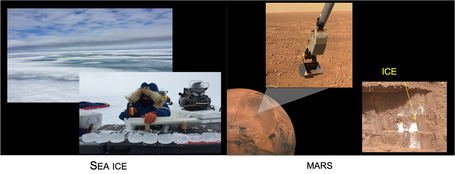Proteomics of Colwellia psychrerythraea at subzero temperatures
|
The mechanisms that enable bacteria to be metabolically active in ice at subzero temperatures have been of considerable interest to studies of polar marine and terrestrial ecology, cryobiology, astrobiology, climatology and atmospheric sciences. Despite numerous studies in the mechanisms of sub-zero microbial activity, the true nature of these processes in marine bacteria remains elusive. The microbial composition and metabolic activity of polar sea ice biota has been previously described using melted sea-ice samples (Deming, 2010; Junge et al., 2011). It is challenging to evaluate the adaptations that organisms adopt to facilitate their survival within these environments due to the difficulty of recreating environmental parameters within the laboratory. For example, the simple introduction of a tracer or substrate to monitor uptake in bacteria at sub-zero temperatures requires the melting of the sample, thereby altering the natural environment.
|
Experimental design for long-term incubations
Environmental Microbiology Special Issue: Microbiology of low-water activity habitats (2015)

In this study we report the results of a long-term experiment monitoring subzero metabolic activity, growth, protein expression and new protein synthesis by Colwellia psychrerythraea strain 34H cells. In order to identify potential molecular strategies that enable 34H cells to maintain cellular integrity under sub-zero temperatures in hyper-saline environments, we examined proteomic profiles of 34H after 8 weeks of -10°C exposure. This allowed us to confidently identify the proteins that were retained and primarily utilized in order to maintain cellular integrity.
Published in Special Issue: Microbiology of low water-activity habitats (eprint available online)
Nunn, B.L., Slattery, K. Cameron, K.A., Timmins-Schiffman, E., Junge, K. (2015) Proteomics of Colwellia psychrerythraea at subzero temperatures - a life with limited movement, flexible membranes and vital DNA repair. Environmental Microbiology. 111, 9009-9014.
In this study we report the results of a long-term experiment monitoring subzero metabolic activity, growth, protein expression and new protein synthesis by Colwellia psychrerythraea strain 34H cells. In order to identify potential molecular strategies that enable 34H cells to maintain cellular integrity under sub-zero temperatures in hyper-saline environments, we examined proteomic profiles of 34H after 8 weeks of -10°C exposure. This allowed us to confidently identify the proteins that were retained and primarily utilized in order to maintain cellular integrity.
Published in Special Issue: Microbiology of low water-activity habitats (eprint available online)
Nunn, B.L., Slattery, K. Cameron, K.A., Timmins-Schiffman, E., Junge, K. (2015) Proteomics of Colwellia psychrerythraea at subzero temperatures - a life with limited movement, flexible membranes and vital DNA repair. Environmental Microbiology. 111, 9009-9014.
Figures from Nunn et al., 2015
Environmental Microbiology Special Issue: Ecophysiology of Extremophiles - Insights into extraterrestrial environments (2021)
Published in Special Issue: Ecophysiology of extremophiles: Insights into extraterrestrial environments
Mudge, M.C., Nunn, B.L., Firth, E., Ewert, M., Hales, K., Fondrie, W.E., Noble, W.S., Toner, J., Light, B., Junge, K.A. (2021) Subzero, saline incubations of Colwellia psychrerythraea reveal strategies and biomarkers for sustained life in extreme icy environments. Environmental Microbiology
Mudge, M.C., Nunn, B.L., Firth, E., Ewert, M., Hales, K., Fondrie, W.E., Noble, W.S., Toner, J., Light, B., Junge, K.A. (2021) Subzero, saline incubations of Colwellia psychrerythraea reveal strategies and biomarkers for sustained life in extreme icy environments. Environmental Microbiology
|
In our most recent study, we report on an experimental design that allowed us to monitor culturability, cell abundance, activity, and proteomic signatures of Cp34H in subzero brines and supercooled sea water through extended long-term incubations. Cp34H was incubated for four months at two subzero temperatures within its growth range, in supercooled seawater or in equilibrium brine, with or without nutrient additions. Shotgun proteomics found novel metabolic strategies, including pathways regulating carbon, nitrogen, and fatty acid metabolism to maintain, for retaining culturability in response to each independent stressor. Statistical analysis of protein abundances uniquely identified in each conditions provide metabolism-specific protein biosignatures indicative of growth or survival states in increased salinity, decreased temperature, or nutrient limitation. Finally, to aid in the search for extant life on other icy worlds, analysis of detected, retained short peptides in -10°C incubations after four months identified over 500 potential biosignatures that could indicate the presence of halophilic or cold-active metabolisms on other icy worlds.
|












